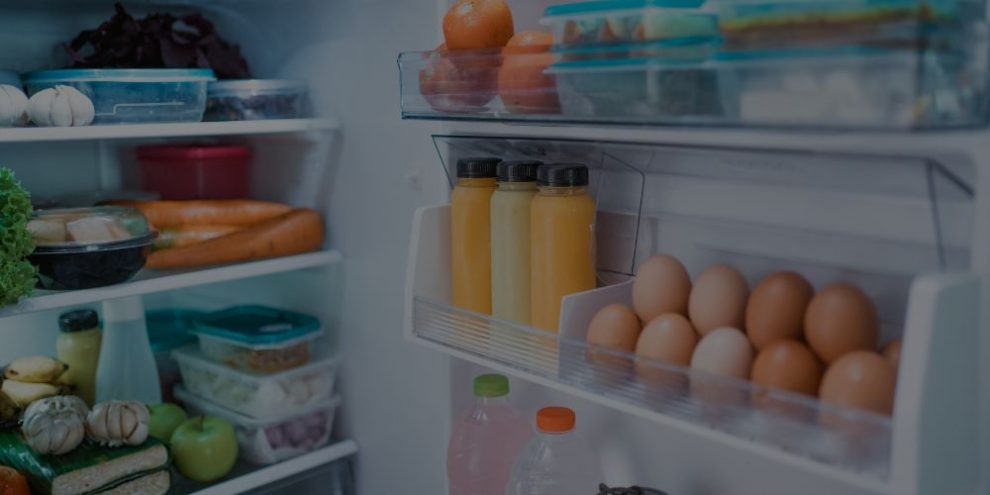
After days of power outages, many people are finally getting their electricity back, while others are still waiting for the lights—and their refrigerators—to turn back on. While there are many things on people's mind, whether or not their food is still safe to eat is a big one.
With so many people asking when food needs to be tossed versus what’s still safe to eat, we thought it was a good time to share some food safety guidelines.
The United States Department of Agriculture Food Safety and Inspection Service (USDA FSIS) has outlined what should be kept and what should go, helping you avoid foodborne illness while minimizing unnecessary waste.
Barrie's News Delivered To Your Inbox
By submitting this form, you are consenting to receive marketing emails from: Central Ontario Broadcasting, 431 Huronia Rd, Barrie, Ontario, CA, https://www.cobroadcasting.com. You can revoke your consent to receive emails at any time by using the SafeUnsubscribe® link, found at the bottom of every email. Emails are serviced by Constant Contact
How long is food okay for in the fridge when the power is out?
The ideal temperature for a fridge is 35-38°F (1.6-3.3°C).
If the power goes out, a fridge will keep food safe for about 4 hours if the door remains closed.
Food in your fridge that you should throw out
Here's a list of refrigerated items that should be discarded if they have been stored in temperatures above 4°C/40°F for over 2 hours.
- Raw or leftover cooked meat, poultry, fish or seafood; soy meat substitutes
- Thawing meat or poultry
- Meat, tuna, shrimp, chicken, or egg salad
- Gravy, stuffing, broth
- Lunchmeats, hot dogs, bacon, sausage, dried beef
- Pizza (with any topping)
- Canned hams labeled “Keep Refrigerated”
- Canned meats and fish (opened)
- Soft cheeses: blue/bleu, roquefort, brie, camembert, cottage, cream,
edam, monterey jack, ricotta, mozzarella, muenster, neufchatel,
queso blanco, queso fresco - Low-fat cheeses
- Shredded cheeses
- Milk, cream, sour cream, buttermilk, evaporated milk, yogurt, eggnog,
- soy milk
- Baby formula (opened)
- Fresh eggs, hard-cooked in shell, egg dishes, egg products
- Custards and puddings
- Casseroles, soups, stews
- Fresh fruits (cut)
- Refrigerator biscuits, rolls, cookie dough
- Cooked pasta, rice, potatoes
- Pasta salads with mayonnaise or vinaigrette
- Fresh pasta
- Cheesecake
- Pastries (cream-filled)
- Pies (custard, cheese-filled, chiffon, quiche)
- Greens (pre-cut, pre-washed, packaged)
- Vegetables (cooked), tofu
- Vegetable juice (opened)
- Baked potatoes
- Commercial garlic in oil
- Potato salad
The following foods have to be discarded if kept in temperatures above 10°C/50°F for over 8 hours.
- Fish sauces (oyster sauce)
- Creamy-based dressings (opened)
- Spaghetti sauce (opened jar)
Food in your fridge that's safe to keep
Here's a list of refrigerated items that should be safe, even if it has been stored in temperatures above 4°C/40°F for over 2 hours.
- Hard cheeses: cheddar, colby, swiss, parmesan, provolone, romano
- Processed cheeses
- Grated parmesan, romano, or combination (in can or jar)
- Butter, margarine
- Fruit juices (opened)
- Canned fruits (opened)
- Fresh fruits, coconut, raisins, dried fruits, candied fruits, dates
- Peanut butter
- Jelly, relish, taco sauce, mustard, catsup, olives, pickles
- Worchestershire, soy, barbecue, hoisin sauces
- Vinegar-based dressings (opened)
- Bread, rolls, cakes, muffins, quick breads, tortillas
- Breakfast foods - waffles, pancakes, bagels
- Pies (fruit)
- Fresh mushrooms, herbs, spices
- Vegetables (raw)
- Unopened sauce, spreads, jams
How long is food good for in the freezer when the power is out?
A full freezer can hold a safe temperature for 48 hours if it is kept close. If your freezer is only half full, it will hold a safe temperature for 24 hours.
If the temperature in the freezer rises above -18°C (0°F) for more than 2 hours, some foods may need to be tossed. But you may be happy tofind out that partially thawed food that still has ice crystals or is below 4°C (40°F) can usually be refrozen safely, though the texture may change.
Alternatively, you can move food that stayed below 4°C (40°F) to the fridge once the power comes back on. If you do, you should treat it like fresh food and consume it within a couple of days.
Fun Fact: Most people think that meat can never be refrozen. But it turns out it can be refrozen, so long as it was slowly thawed in the fridge.
Food in your freezer that you can refreeze
Here's a list of food you can refreeze so long as the food still has ice crystals and it was kept fridge cold for the entire power outage (4°C/40°F or colder):
- Beef, veal, lamb, pork, ground meats
- Poultry and ground poultry
- Variety meats (liver, kidney, heart)
- Casseroles, stews, soups
- Fish, shellfish, breaded seafood products
- Milk
- Eggs (out of shell) and egg products
- Cheese (soft and semi-soft)
- Shredded cheeses
- Casseroles containing milk, cream eggs, soft cheeses
- Cheesecake
- Vegetable juice
- Home or commercially packaged or blanched
- Cakes, pies, pastries with custard or cheese filling
- Pie crusts, commercial and homemade bread dough
- Casseroles - pasta, rice-based
- Frozen meal, entree, specialty items (pizza, sausage and biscuit, meat pie, convenience foods)
The following foods can be refrozen if thawed, even if it has been stored in temperatures above 4°C/40°F for over 2 hours. (If you see mold, smell yeast or sliminess develops, then throw out immediately.)
- Fruit juices
- Hard cheeses
- Home or commercially packaged fruit
- Breads, rolls, muffins, cakes (without custard fillings)
- Pie crusts, commercial and homemade bread dough
- Flour, cornmeal, nuts
- Breakfast items - waffles, pancakes, bagels
If you're uncomfortable refreezing items from either of these lists, they can be moved to the fridge but should be treated as fresh food and eaten within a couple of days.
Food in your freezer you should throw out
Here's a list of items that should be discarded if they are thawed and have been stored in temperatures above 4°C/40°F for over 2 hours.
- Ice cream, frozen yogurt (even if it still has ice crystals)
- Beef, veal, lamb, pork, ground meats
- Poultry and ground poultry
- Variety meats (liver, kidney, heart)
- Casseroles, stews, soups
- Fish, shellfish, breaded seafood products
- Milk
- Eggs (out of shell) and egg products
- Cheese (soft and semi-soft)
- Shredded cheeses
- Casseroles containing milk, cream eggs, soft cheeses
- Cheesecake
- Cakes, pies, pastries with custard or cheese filling
- Casseroles - pasta, rice-based
- Frozen meal, entree, specialty items (pizza, sausage and biscuit, meat pie, convenience foods)
Here's a list of items that should be discarded if they are thawed and have been stored in temperatures above 4°C/40°F for over 6 hours.
- Vegetable juice
- Home or commercially packaged or blanched
Food safety myths
There are a lot of misconceptions about food safety, especially when it comes to power outages. Let’s clear up a few of the biggest myths:
"If it smells fine, it’s safe to eat."
Some bacteria, like Salmonella and E. coli, don’t produce strong odors. Just because something looks and smells normal doesn’t mean it’s safe.
"If I cook spoiled food really well, it’ll be safe."
While heat can kill bacteria, some toxins (like those from Staphylococcus aureus) aren’t destroyed by cooking. If food has been in the danger zone (above 4°C/40°F for more than 2 hours), it’s best to toss it.
"I can just refreeze anything that thaws."
Not exactly. While food that stays below 4°C (40°F) can be refrozen, if it’s been warmer for too long, bacteria can grow. Also, refreezing changes texture—meat, fish, and dairy may become mushy.
"Power went out, but the fridge door was closed, so everything is fine."
A closed fridge only stays safe for about 4 hours without power. If it was out longer, some food will need to be discarded.
"Freezing kills all bacteria."
Freezing stops bacteria from growing, but it doesn’t kill them. Once food thaws, bacteria can become active again. That’s why proper thawing and cooking are important.
Food safety tips
While you can’t control when electricity returns, you can take steps to minimize waste and reduce your risk of foodborne illness by planning ahead.
Here are some practical tips to help you make the best decisions about what to keep, what to toss, and how to prepare for future outages.
- The Frozen Coin Trick – Put a glass of water in your freezer, let it freeze, and place a coin on top. If the power goes out and the coin sinks to the bottom, your freezer fully thawed and refroze—meaning some food may be unsafe. If it’s still near the top, your food likely stayed cold enough.
- Keep a Thermometer in Your Fridge & Freezer – This takes the guesswork out of food safety! Your fridge should stay below 4°C (40°F), and your freezer at -18°C (0°F).
- Use Ice Packs & Coolers for Backup – If you know a storm is coming, fill coolers with ice packs. If the power goes out, you can transfer perishables to extend their shelf life.
- Keep an Eye on the Outside Temperature – If it is a colder time of year, take note of the outdoor temperature. You may be able to keep food outside in animal safe containers or use the cold temperatures to keep icepacks cold.
- Keep the Fridge & Freezer Closed – Every time you open the door, cold air escapes! Try to grab what you need quickly and keep doors shut as much as possible.
- Group Frozen Foods Together – A full freezer stays colder longer. If you have space, add ice packs or frozen water bottles before an outage to help keep temperatures low.
- Label & Date Your Food – If you refreeze items, mark them with a date so you can use them first. Even if they’re safe, the quality may decline over time.
- Rotate Emergency Supplies – Keep a small supply of non-perishable foods like canned goods, peanut butter, and dried fruits so you have safe food on hand during an outage.
Power outages can be stressful, and food safety is a major concern. While it’s frustrating to throw food away, it’s always better to be safe than sorry when it comes to preventing foodborne illness. If you're ever unsure about something, remember the golden rule: When in doubt, throw it out.
If you're still without power, consider using coolers with ice packs for perishable items, and check with local community centers or neighbors for resources. Stay safe and take care!











